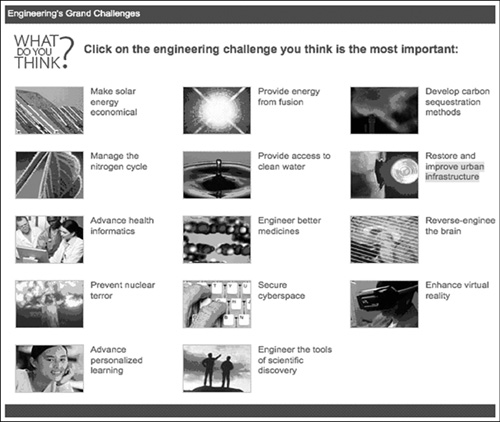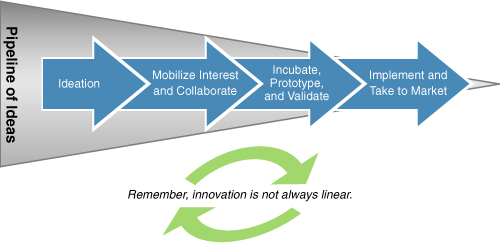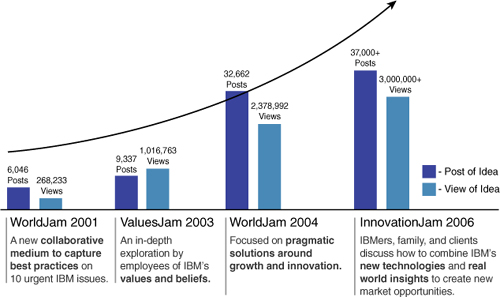The dense, seductive aroma floods your brain as you open the door. Your senses come alive as you hear the milk being steamed by the barista and the grinder at work on another batch of Sumatra. You still haven’t figured out why they call the small size cup “tall,” but you decide it doesn’t matter. You’re just here for the coffee.
Some would argue that Starbucks has achieved a bit of coffee perfection with its powerful, exotic-sounding brews. Perhaps, however, you have an idea about improving on that perfection. If you do, why not let them know? It’s easy enough to do at mystarbucksidea.com.
Mystarbucksidea.com is one example of an exploding trend in the corporate world today—to explore and act on ideas from a community of interested volunteers to grow and more effectively compete in a rapidly changing world. Competition today, as any business person will tell you, is fiercer than ever. Accelerated globalization and advances in technology drive companies to constantly seek innovative ideas that differentiate them from the competition and allow them to respond quickly to changing business dynamics. And growth—perhaps even survival—depends on constant innovation.
But where do innovative ideas come from? Your top management? R&D? University research? These are good choices, but, as shown in Figure 9.1, the executives who responded to a global CEO study overwhelmingly identified their employees, customers, and business partners as the top sources for innovative ideas.[1]
Figure 9.1. The best business ideas and innovations come from employees and business partners, according to a 2006 survey of CEOs.
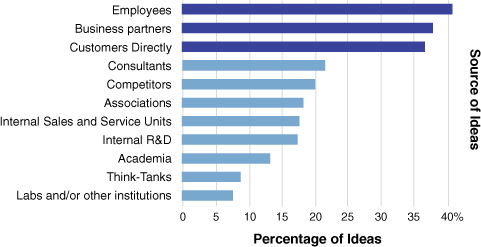
Before moving away too quickly from this bit of information, consider that these survey results represent a profound reversal from historical precedent. If this survey had been taken 50 years ago, or even 30 or 20 years ago, the results might have been the opposite of those shown in Figure 9.1. The consequences of relying on internal R&D only, or on the brainpower of a few C-level executives, can perhaps best be seen in the disaster currently unfolding in many companies today. While other, more nimble companies were busy improving their products and bringing to market what their customers were demanding, many industrial-age companies were focused on “business as usual.” In the Social Age, smart companies have discovered that tapping into the collective sentiments and innovative thinking of their customers, employees, and partners is indispensable to long-term success. Without social networking, such access to the collective mind can be possible, but it is difficult and expensive. Now, with wikis, blogs, forums, and other social tools, the incredible power of the thoughts of all these constituencies is literally at our fingertips.
To fully appreciate the incredible power of social networking for driving innovation at your business, we need to look first at the power of the many minds that make up our social networks. In earlier chapters, we reviewed the tools and patterns of social networking transformation that have reshaped our world—making it more informed, connected, and smarter than ever. The Social Age, however, is not about wiki servers, blog interfaces, and survey results; the Social Age is about human connections. People want to connect with other people. Social networking tools are merely the conduit through which people connect.
As with any technology, much good can arise from the instantaneous information, increased social connections, and open collaboration available in our world today. A socially networked world can foster increased cultural understanding, peace, and growth. In the Social Age, perhaps more than ever before, people and businesses have an extraordinary opportunity to use social networking to collaborate, generate new ideas, and bring to market the innovations that will drive the next wave of economic and societal growth.
Behind all this unprecedented social interaction is the miraculous human brain. From the brain arise all new ideas and social impulses. Great minds are constantly thinking of ideas to make a better world and about ways to translate those ideas into new innovations and products.
It has long been understood that some environments are just healthier for the human brain. Environments—especially work environments—that challenge us and foster our creativity bring out the best in us. By contrast, organizations that don’t foster creativity just as quickly waste this tremendous resource within each employee. “Use it or lose it” is just as true for our brains as it is for our muscles! Exercise your brain regularly and it becomes agile, quick, and resilient. Corporations that encourage social networking activities and social tools for collaboration not only reduce the degrees of separation between their employees, but also provide a work environment that can be conducive to reducing mental stress and generating new ideas.
Social neuroscience describes patterns in the brain related to controlling motor skills and instinctive social needs. As early as the mid-19th century, when German physician and physiologist Emil Du Bois-Reymond (1818-1896) first identified the relationship between electrical current and nerve function, we recognized there is something unique about the human brain.[2] As we explored further, using breakthrough technologies like magnetic resonance imaging (MRI),[3] it became apparent that our brains are what make us social animals. Further, these studies have helped us understand there is a division between the unconscious and conscious mind. While we spend years training the conscious part of our brain through formal education, job training, and our cultural and social environment, it is the unconscious mind—the part of our brain we can’t consciously manipulate—that gets leveraged in many unexpected and productive ways.
This unconscious brain appears to have some cognitive patterns built in that are shared by all humans. Emotions and visualization of objects, for example, happen in the same part of the brain regardless of your gender, race, or social background. Exciting new neuro-technologies use these standard signals to essentially “read” our brains. As we said before, MRIs can pick up these signals, and now these new devices are programmed to pick up on some of our basic instinctive thoughts. As much as we think of ourselves as unique—and we are—a large part of our brain has been standardized by the process of evolution. With our growing understanding of the amazing functioning of the brain, incredible technology advances are already beginning to appear.
Previously only a science-fiction writer’s dream device, Emotiv Inc.’s EPOC neuro-headset, based on noninvasive electroencephalography, leads the way in thought-based interaction with computers. Leveraging the things we know about the electrical activity of the brain, along with the incredible processing power of today’s computers, Emotiv claims that EPOC can, at a relatively sophisticated level, read the brain electrical activity (thoughts) of users and their physiological responses. For the first time, this capability allows interaction with computers in a more human way.
“Why do we fly people thousands of miles for a meeting, instead of opting for a much less expensive phone call?” said Tan Le, Emotiv’s president and cofounder, seen in Figure 9.2. Answering her own question, she said, “Because there is so much more to human communication than just the voice. Body language, posture, eye contact—all give us valuable information about our relationships. EPOC allows us to begin interacting with our computers in similar ways.”[4]
The potential impact of EPOC and similar technologies in the Social Age is profound and perhaps a little unsettling. For example, a gamer can use EPOC to move his avatar through a virtual world. Or by generating a high level of excitement, the gamer can invoke superpowers in his avatar. Le said that a group of children Emotiv brought in enjoyed playing with a computer wizard game using the keyboard and joystick. The children were then given the EPOC neuro-headset and again asked to play the wizard game. The children described their keyboard and joystick experience as “manipulating the wizard.” When using the neuro-headset that enabled them to move the wizard with just their thoughts, however, the children commented that they were the wizard. As Emotiv is demonstrating, by removing computer interfaces and going directly to the neuron wave messages, a deeper sense of participation in the computer game is enabled.
The ability of our thoughts to control computer applications promises to have incredibly positive benefits in areas beyond just gamers who look for a totally immersive gaming experience. Music, art, market research, and prosthesis and robotic control in medicine are among countless applications that can benefit from thought-controlled computers. Devices such as EPOC, and the things these devices can tell us about the highly predictable functioning of our brains, will have profound implications for social networking tools.
We gain great insight into the predictability of human social behavior when we understand the incredible “standardization” of the human brain and, more importantly, of our subconscious mind. As a recent landmark study helped demonstrate, our brains have a great deal in common, whether we’re from Kenya or Kalamazoo.

In a research partnership between the National Geographic Society and IBM, DNA samples from thousands of people around the world revealed the reason we’re all “wired” the same—we all have the same parents! The Genographic study, which I had the privilege of leading on the IBM side, concluded that all modern humans descended from a small group of a few thousand people, who lived in east Africa around 70,000 years ago (see Figure 9.3).
Figure 9.3. Genographic map tracing the origins of humans to two common ancestors in sub-Saharan African (CFA and CMA).[5]
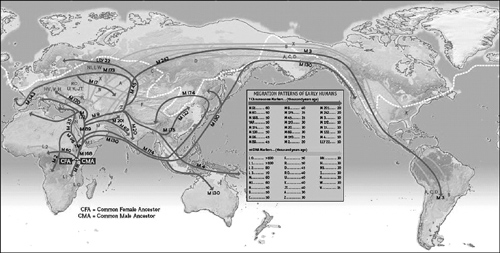
The reality is we all come from the same place in a long and beautiful evolutionary path. Social contact and interaction is primal, and part of what makes us human. We need this interaction; and in the Social Age, this primal instinct is expressed very clearly in social networking.
Ironically, the extensive and highly productive interaction between teams from IBM and the National Geographic Society actually helped demonstrate the reality of this social instinct.
The Social Age spirit of collaboration that began with the Genographic project in 2005 continues today as Genographic researchers increasingly use blogs to work even more efficiently. Above all, the Genographic Project demonstrates—beyond any shadow of a doubt—our common ancestry. It is this common heritage that helps explain why our brain’s electrical patterns, physiological responses, and social instincts appear to follow a common blueprint across cultures. Today, the Genographic Project continues to release new findings and to offer everyone the opportunity to learn more about the way they fit into the “family of man.”
Each of us have approximately 100 billion nerve cells (neurons), interacting with each other via tiny electric charges, in a process that solidifies memories, drives reasoning, and mediates social behavior. Every brain is unique; the external surface of the brain folds in distinctive ways for each of us, reminiscent of fingerprints. That’s right—you’re as unique as you always thought you were!

Now imagine what happens when you connect your brain activity to the brain activity of many others. You quickly create a collective value that is far greater than the sum of its parts.
In the Social Age, we face an unprecedented host of challenges and projects of global scope, with profound implications for society: global warming, economic uncertainty, population growth, and political upheaval, among others. Many, if not all of these challenges are already being studied, often guided by new social tools.
Engineering’s Grand Challenge is a collaborative effort sponsored by The National Academy of Engineering, currently under way among the best scientists and engineers in the world (Figure 9.4). The Challenge’s objective is to generate new proposals to solve some the thorniest problems in the 21st century.[6] As the Grand Challenge demonstrates, nonprofit organizations, academia, and businesses are all exploiting the power of social networking to generate ideas that will make the world a better place to live.
The brain is an electric machine that processes both physical and mental stress in the same way. An emotionally abusive environment causes your brain to release cortisol, referred to as the stress hormone—the identical compound produced by your adrenal cortex under physically painful conditions. Cortisol lowers your immune system, increases your blood pressure, and decreases bone formation. Perhaps not surprisingly, cortisol also reduces thinking capacity.

MRI studies provide hard evidence that social pain and feelings of unfairness appear in the same location of the brain as physical pain—the brain doesn’t distinguish between them.[7] Similarly, the National Institute of Mental Health’s Thomas Insel and Stanford University’s Russell Fernald point to growing evidence that suggests that social isolation and social separation are health risk factors comparable to well-known risk factors like smoking and obesity.[8]
By contrast, positive, supportive social interactions cause changes in the adult brain similar to the changes brought on by feelings of love and admiration for an exquisite artwork or good food. Feelings of meaningful social contribution and connections at work provide a sense of stability and security that releases stress, limits the production of cortisol, and thus increases the ability of employees to think. Are you a runner, or do you enjoy a good workout? Then, you’ve probably experienced the opposite of stress hormones: endorphins—the natural pain reliever. Produced by the hypothalamus and the pituitary gland, endorphins are experienced during pleasurable events, excitement, and strenuous exercise.[9]
The formula to lower cortisol and raise endorphins is simple: lower stress in the work environment, which ensures a workforce that functions at optimal mental capacity to outpace the competition in generating new ideas. A collaborative and friendly work environment helps employees be more productive, think more clearly, and be more satisfied in their work.
Scientists have discovered that a lack of mental exercise is one of the main culprits for declining mental agility as we age.[10] Just like muscles, brains need exercise! And what better place to exercise our brains than at our place of work, doing the thing we do best? Social networking with others helps you exercise and use your brain in ways you never thought you could, across all parts of your company. (See the “Maximize Your Brain!” sidebar.)
An employee’s success depends on his or her ability to constantly think, quickly adapt, and stay in front of market forces that can affect your market and your business model. Merely lowering costs by working hard and continually improving existing processes is not necessarily the way to succeed in today’s light-speed business environment—cost-savings can take you only so far. Many companies recognize this and look first at their innovation processes for answers. Here is a real brain exercise: Create innovations that reinvent your business model or that create new products that beat the competition.
Perhaps the best way to encourage innovative thinking is to establish a formal process that encourages employees to come up with new ideas and rewards employees who contribute ideas that are most helpful to the business. Empowering your employees to collaborate in business transformation efforts and idea generation helps create a team atmosphere and sends a strong message to the rest of the organization that the business values out-of-the-box thinking. We take a deeper look at ideation in the next section, and in Chapter 10, “Social Innovation,” we explore the important components of a formal innovation process.
As we’ve already discovered, social software, such as wikis and blogs, is the ideal enabling technology to gather, share, and act on a wealth of innovative ideas from diverse participants across organizational and geographic boundaries. In the second half of this chapter, we look at several companies that have mastered collaborative innovation by using social software to drive their ideation process.
Ideation occurs when individuals or groups generate ideas, concepts, and hypotheses that can be explored or acted upon. Ideation is about thinking abstract thoughts that apply to a specific situation.
Typically, ideation is a formal, facilitated process of limited duration generally referred as brainstorming sessions. Although these traditional sessions can generate great ideas, ideation is most valuable when it is ongoing. An open, collaborative, online ideation environment is ideal for this purpose. When targeting a specific topic or problem, however, an “ideation event” of limited duration might be the best choice. For this purpose, IBM sponsors ideation “Jams” that engage our employees, customers, partners, academics, and other industry experts. We look at Jams in more detail later in this chapter.
Social ideation is a collaborative process that transcends organizational silos and geographical and cultural differences. As we explored in Chapter 3, “Wikis: Bringing the Crowds to You,” when large numbers of individuals collaborate, from diverse backgrounds and areas of expertise, the results can be amazing. Experts from all parts of the business collaborate to enhance the original idea and build on it, often taking it into different, even more innovative directions.
Companywide ideation initiatives offer a host of benefits, such as cost-savings, process improvements, productivity enhancements, innovative business model changes, new areas of opportunity, and ideas to enhance employee well-being, among others. Extend social ideation to include customers and partners, and you can identify customer satisfaction improvements, quickly address unmet client needs, and capture unique business opportunities. Finally, social ideation not only captures innovative ideas but can also help speed them to market.
Social software that provides a collaborative platform accelerates the ideation process along with your company’s business agenda. Forums, wikis, blogs, micro-blogging, social tagging and bookmarking, social ratings and reviews, and file-sharing tools can all facilitate social ideation.
As we mentioned at the beginning of this chapter, mystarbucksidea.com (“MSI” to its community) allows consumers to provide suggestions on ways that Starbucks can improve its coffee or its stores. The community votes on and comments on favorite suggestions. The mission of mystarbucksidea.com is to help Starbucks connect with its customers and in a way to cocreate the future of the company.
MSI has four key components—Share, Vote, Discuss, and See. Each of these steps promotes a virtuous cycle of discussion, interaction, and ultimately action that benefits both customer and brand. From the day it was launched, MSI has been a hit. In less than six months, nearly 75,000 ideas had poured in (no pun intended!), many of which were acted on by Starbucks.
Crowdsourcing as a concept came to be more widely known after James Surowiecki’s Wisdom of Crowds was published in 2004.[11] But some companies had been practicing the “crowds” concept well before then. Pharmaceutical giant Eli Lilly launched InnoCentive.com as an in-house innovation incubator.[12] The company originally used the site to post problems that its employees had been unable to solve, and from the beginning the site saw positive results, immediately helping Lilly solve more than one-third of the problems posted.
InnoCentive has since evolved into its own independent company and now serves as a global, online marketplace where organizations in need of innovation can tap into a global network of more than 160,000 of the world’s brightest problem solvers.
InnoCentive brings together “seekers” of answers to problems and “solvers,” those crowd-sourced experts around the world who provide possible solutions. To incentivize registered solvers, seekers offer significant financial awards for the best solutions. InnoCentive has an eight-year track record of success and to date has paid out more than $3.5 million in awards to more than 300 winning problem solvers.
From the earliest days of IBM, founder T.J. Watson recognized the importance of employee participation in the innovation process. This participation began as a simple wooden box, labeled “IDEAS,” into which employees could drop their suggestions. Eventually this rustic—and somewhat inefficient—system morphed into the agile, socially networked ThinkPlace, an always-on ideation portal, open to all employees in more than 2,000 locations and 230 countries worldwide. Participants can submit ideas, comment on the ideas of others, add to ideas, rate them, and follow the progress of an idea.
ThinkPlace goals include
• Provide a single, consistent global management system for innovation that supports the management of new ideas.
• Create a culture in which collaboration and interaction across silos is considered an essential element of innovation.
• Educate employees on your company’s approach to innovation.
• Reward innovators and innovative ideas in tangible, visible ways.
More important than having good social ideation tools is having an effective end-to-end innovation process. Identify the problems and challenges to solve, as illustrated in Figure 9.5. Then leverage social software to generate and collaborate on ideas, provide incubation and prototyping support, furnish programs to validate the ideas, and document the value realized and reward contributors.
A unique, critical role in any successful ideation event or site is that of catalysts. Catalysts are volunteers from all parts of your organization who work with idea submitters to help them get visibility for their idea, access incubation resources, prepare business cases, and introduce others to their idea. IBM Program Director Paul Baffes created the catalyst role at IBM and spoke about its importance in maintaining innovation momentum:
Catalysts are a key part of the “engine” that drives innovation. Their role, as the name implies, is to act as an extra boost to help idea submitters get their ideas moved forward.... Catalysts are facilitators that help make connections, offer advice, bridge gaps, make introductions, and generally become a partner for idea submitters.
You might want to consider doing as we did at IBM, and reward catalysts for successfully facilitating numerous ideas and helping to recruit and train other catalysts. We offer the rank of Master Catalyst to those who reach certain performance benchmarks.
By the end of 2008, 19,000 ideas had been submitted with more than 150,000 employees participating, and more than 1,000 IBMers volunteered as ThinkPlace catalysts. Ideas adopted and documented for business impact were highlighted as “wins,” and to date more than 500 of these wins have resulted in millions of dollars in business value for IBM. Value is realized through cost-savings, productivity improvements, revenue growth, and employee well-being.
“Jams have helped change our culture and the fundamental way we collaborate across our business.”
IBM chairman and CEO Sam Palmisano
For nearly a decade, IBM has used Jams to capture the collective voice of IBM (Figure 9.6). These companywide brainstorming events have become a management tool of choice for business collaboration and enterprisewide transformation. Jams use Web 2.0 technologies to provide a social ideation environment, along with processes that elicit ideas from a large number of diverse participants around a specific topic. Data mining is used during and after a Jam to discern key themes for action.
IBM’s Jam Program Office director Liam Cleaver commented that Jams share some of the characteristics of crowd sourcing. “They are a way to reach out online to a broad group of people to help solve a problem,” he said. According to Cleaver, Jams go one step beyond crowd sourcing because “...we go out across a whole enterprise or industry. It’s a defined population helping to solve a business problem tapping into their collective smarts and passion for the topic.”
At their core, Jams are “innovation events.” They are a powerful engine for change across an entire organization, during times when the collective brainpower and support of a defined population is critical to the success of a new strategy or vision. “Jams are a business tool,” said IBM senior manager Kristine Lawas. “They’re not a free-for-all social networking experience. The user experience of a Jam is deliberately orchestrated so that everyone has an equal voice.”
The time-limited nature of Jams, typically 72 hours of intense global collaboration, creates a sense of corporate excitement or “buzz” that drives participation. The online event, however, is only the culmination of a period of focused preparation. Depending on audience size, a typical Jam requires between 6 and 16 weeks of preparation, followed by 1 to 3 weeks for post-Jam analyses. As with any event, the communication and marketing of the event (intent, desired outcome, schedule, and so on) is critical to the Jam’s success and to the adoption of the post-event ideas and plans.
A successful Jam is typically organized around three to four strategic topics with collaboration taking place in corresponding forums. Each strategic area is moderated by a senior leader who helps guide the discussions and refines or refocuses it as needed. Consider using real-time text mining and analysis tools created to analyze comments and synthesize them into key themes, visible to participants in theme clouds. Other features, such as online polls, can help connect (and re-connect) users with the event.
Four key elements are common to every Jam:
• Online collaborative discussions—For audiences ranging in size from a few hundred to hundreds of thousands
• Innovation events—To capture the pulse of the group or solicit specific ideas to critical business issues
• Jam hosts and facilitators—To guide participants to build on each other’s ideas
• Real-time text analyses and data mining—To highlight emerging trends and synthesize actionable results
Jams are powerful catalysts to kick-start the innovation process and highlight strategic issues and challenges. They can transcend culture, language, and geographic distance to harness the collective knowledge of the organization. A rich store of priceless ideas and comments are available both during and after the Jam, which can uncover key themes and hot topics. Prioritizing this data and using it as an ongoing source of ideas offers tremendous long-term benefits.
• People want to connect with other people. Social networking tools are merely the conduit through which people connect.
• Great minds are constantly thinking of ideas to make a better world and ways to translate those ideas into new innovations and products.
• Social networking connects the amazing power of individual brains to create a collective value that is far greater that the sum of its parts.
• A favorable work environment is the key to innovation. Feelings of meaningful social contribution and connections at work provide a sense of stability and security that releases stress.
• Ideation occurs when individuals or groups (in the case of social ideation) generate ideas, concepts, and hypotheses that can be explored or acted upon.
• Social software that connects people, locates experts, and provides a collaborative platform that accelerates the ideation process along with your company’s business agenda.
• Jams are powerful catalysts for change across an entire organization, during times when the collective brainpower and support of a defined population is critical to the success of a new strategy or vision.


